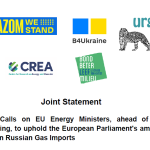The climate neutrality puzzle is massive. As EU affairs ministers meet in Brussels tomorrow (28 January), they should ensure €260 billion are invested annually to lead a fair and just transition away from fossil fuels, campaigners write.
This op-ed was originally published by Euractiv on 27 January 2020.
Raphael Hanoteaux is the EU policy officer at CEE Bankwatch Network; Katie Treadwell is the energy policy officer at WWF European Policy Office; Markus Trilling is the finance and subsidies policy coordinator at Climate Action Network (CAN) Europe.
European affairs ministers meet on 28 January for decisive discussions about Europe’s finances for 2020 and beyond. The EU will soon have all the necessary jigsaw pieces in place to solve the puzzle of reaching higher climate ambition, but only if the final picture reveals a fossil fuel phase-out and guarantees for the public to have a say in how climate money is spent.
The first piece was laid on 12 December when the European Council committed to achieving climate neutrality by 2050. This implied bringing down all greenhouse gas emissions of the economy close to zero by then.
The second followed two weeks ago when the Commission revealed its €1 trillion investment plan to deliver a Green Deal, which included a proposed €7.5 billion for a Just Transition Fund and a Cohesion Policy with €373 billion for the EU’s coal-dependent and neediest regions, respectively.
Yet the final shape of Cohesion Policy funding up to 2030 is still in the making, with some Member States still pushing for EU funding for fossil fuels. This is a mistake.
As the numbers suggest, the climate neutrality puzzle is massive. The Commission estimates as much as an additional €260 billion annually is needed to build a carbon-neutral economy and lead a fair and just transition away from fossil fuels. To achieve this, all EU funding instruments must align with the commitments of the Paris Agreement.
We have no time to lose since drastic emissions cuts by 2030 will be key to reaching climate neutrality by mid-century. Nor do we have money to waste. As negotiations culminate between the Parliament and the Council over Cohesion Policy, the transformational potential of these regional development funds for climate neutrality can only be unlocked if three decisions are made.
First, no money can be spent on fossil fuels. Such subsidies have no future in a carbon-neutral continent. Yet some Member States continue to fight for exemptions so that they can continue business as usual, in particular with investment in fossil gas infrastructure. This is a crucial mistake.
The lifetime of gas infrastructure projects is long, meaning any new build will soon become a stranded asset and lock Europe into carbon-intensive technologies. Due to the self-perpetuating inertia that investments into fossil fuel-based energy systems create, the Commission’s proposal to exclude harmful activities from the scope of Cohesion Policy is a welcome step and should be defended.
Second, regional authorities, social partners and civil society should be included in solving the climate neutrality puzzle. Financial instruments like Cohesion Policy work best when designed from the bottom-up.
This ‘partnership principle’ enables citizens and stakeholders to ensure that investments are adapted to local and regional needs and priorities, resulting in greater acceptance by, and benefits for those where projects are implemented.
Cohesion Policy is an expression of economic, social and territorial solidarity across the different regions of the EU and is a proven catalyst in the fight against climate change. Yet the EU institutions have so far shown a reluctance to commit Cohesion Policy funds for what they are intended, preferring instead to continue business as usual.
For these reasons, a third step is to ensure that countries receiving Cohesion Policy funds spend the money on measures that can address climate neutrality.
This so-called ‘mainstreaming’ means setting a binding objective and mandatory spending floor of 40% on investments in sustainable and transformative projects, listed in Cohesion Policy as “Policy objective 2: ‘A greener, low-carbon Europe’”.
Whether or not legislators are up to solving the challenge will decide whether Cohesion Policy truly delivers solidarity between richer and poorer regions while driving investments in clean energy in the regions that need it most. Only with these pieces in place will the next EU budget contribute to solving Europe’s climate neutrality puzzle.



